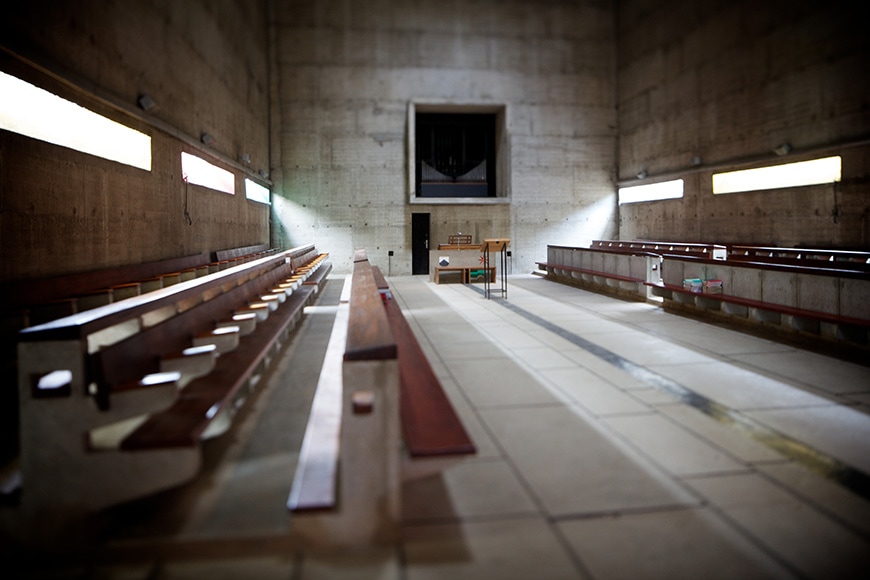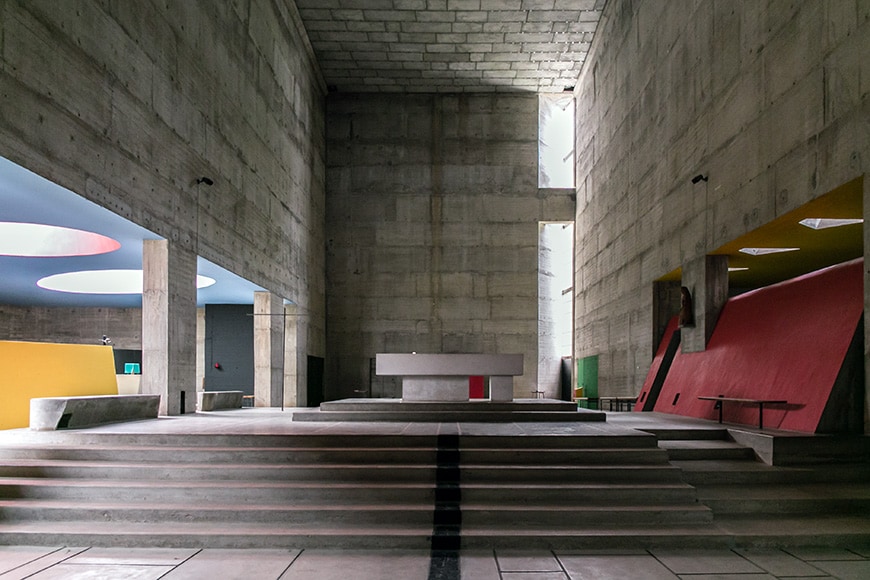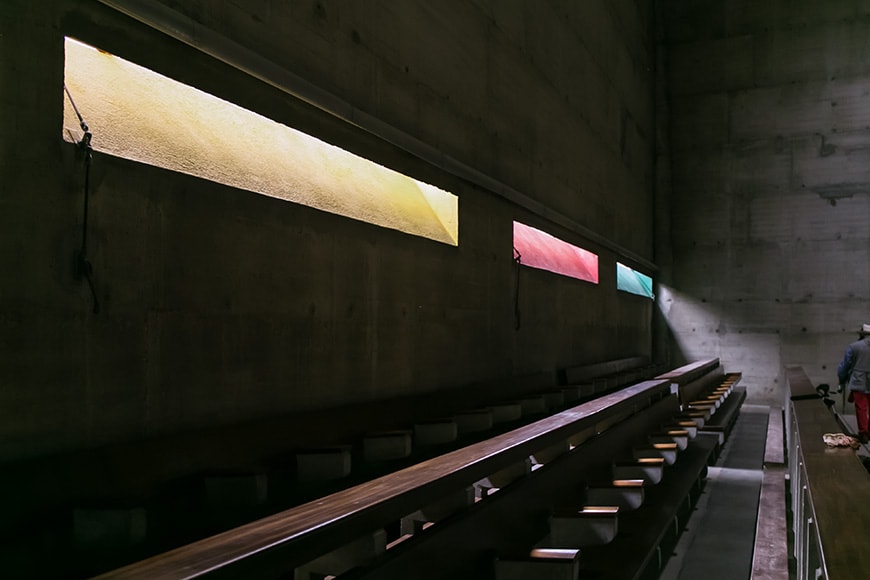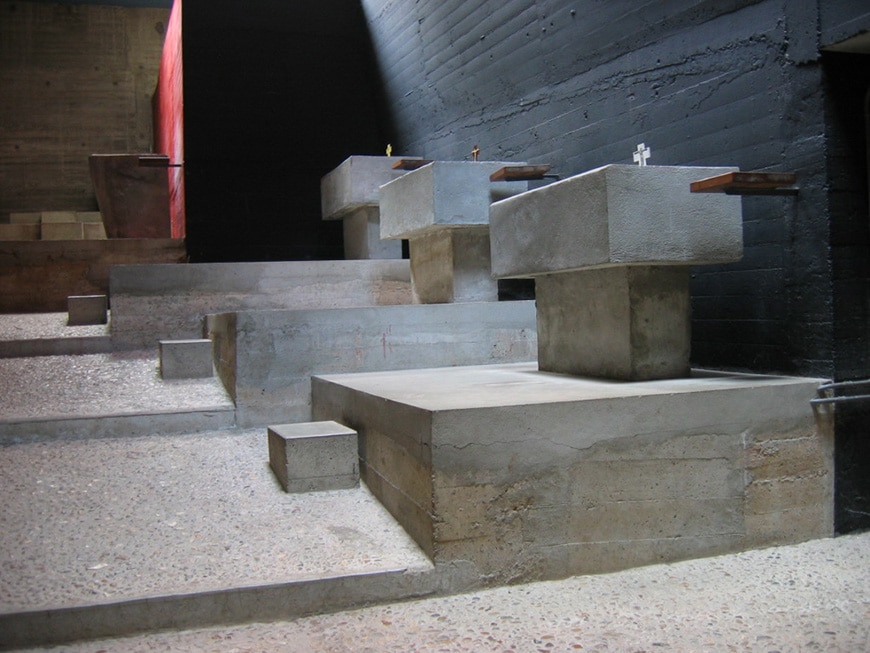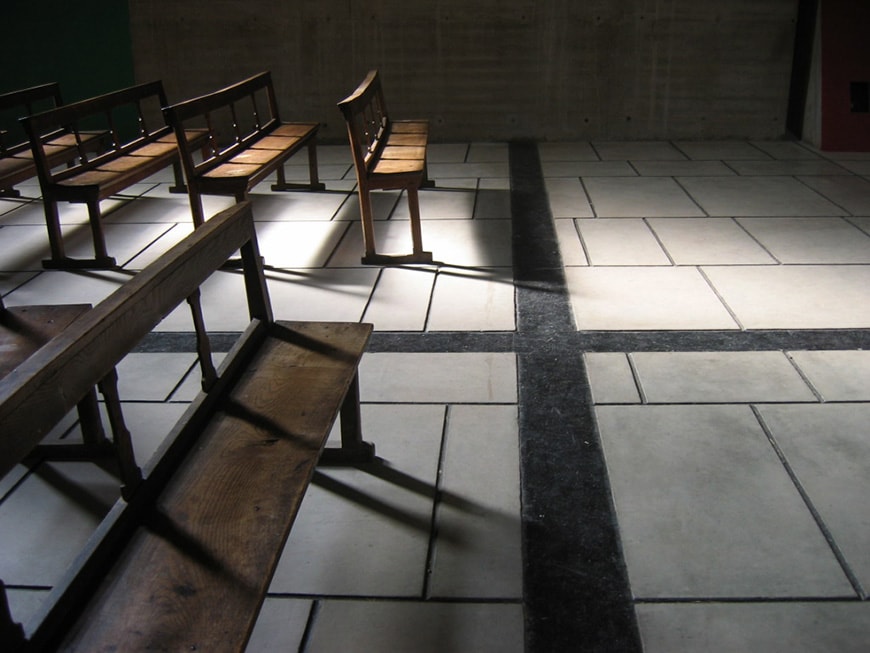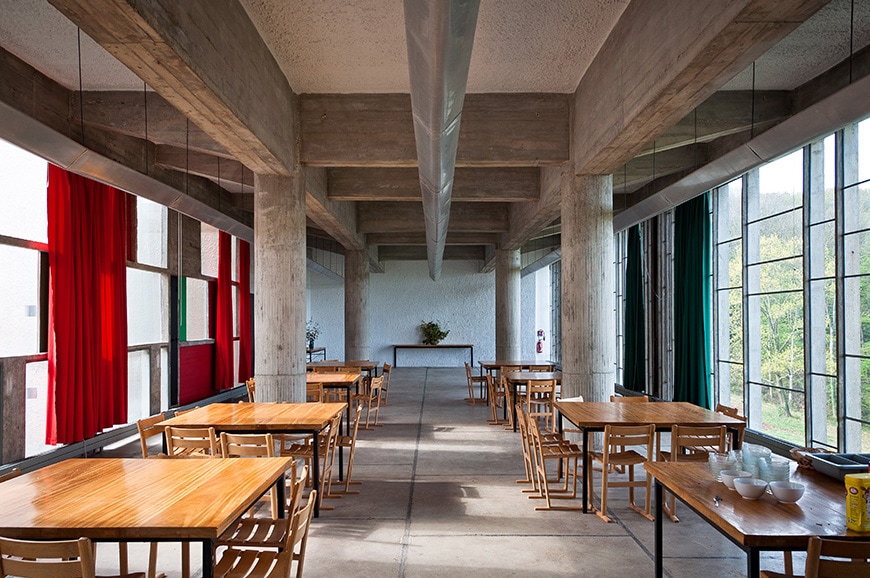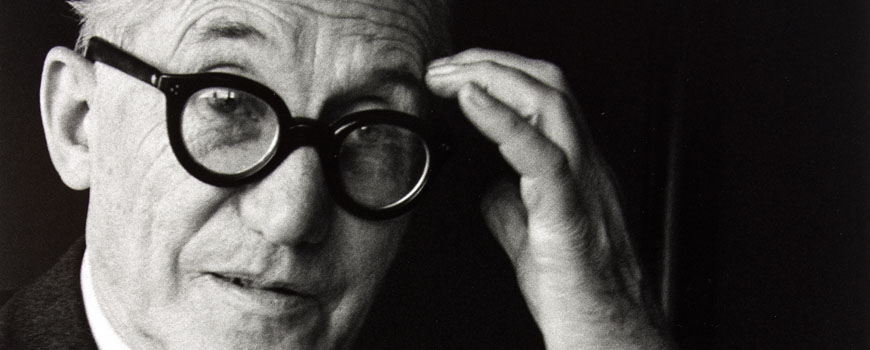Le Corbusier – Monastery of Sainte Marie de la Tourette, Éveux, France
Auvergne-Rhône-Alpes, France
Phone: +33 (0)4 72 19 10 90
Website: https://www.couventdelatourette.fr/home.html
How our readers rate this museum (you can vote)
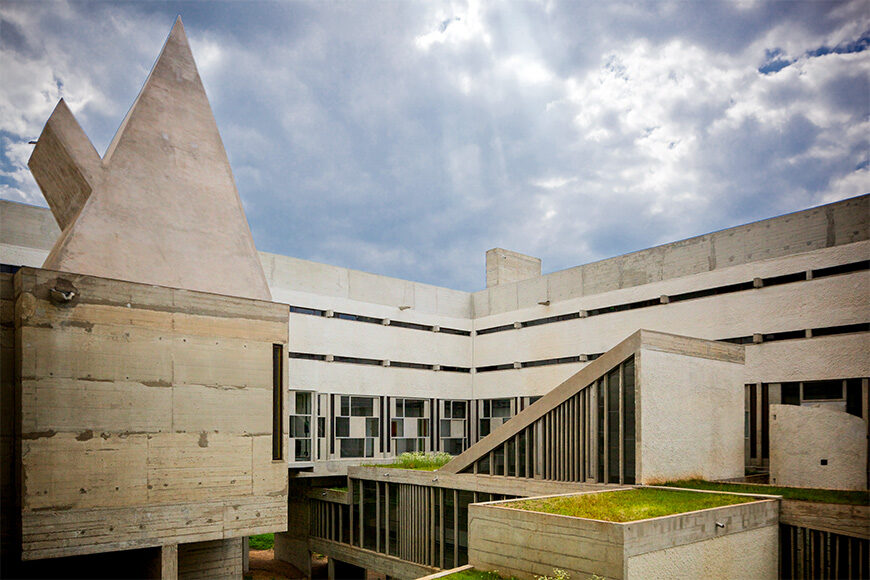
Sainte Marie de la Tourette is a Dominican monastery in Éveux, a French village about 25 kilometers / 16 miles northwest of Lyon, designed by Le Corbusier in 1953.
Often called just “La Tourette”, the convent is one of the most famous and iconic buildings designed by Le Corbusier after World War Two and, since 1970, has been open to the public for guided tours and overnight stays.
Cover image: view of the Sainte Marie de la Tourette cloister; photo Aurelien Guichard CC BY-SA 2.0 via Flickr
History
Like the Notre Dame du Haut Chapel in Ronchamp, Sainte Marie de la Tourette is set on a slope surrounded by a pastoral landscape in the countryside of south-central France. The lot on which the monastery was built was bought by the friars, who planned to relocate to the Lyon area from Chambery, in November 1943.
In February 1953, the Dominican brothers asked Le Corbusier to design the new monastery (or more precisely a priory, that is a Catholic monastery headed by a prior); the choice of the Swiss-French architect, who was 65 years old at the time, was influenced by a suggestion by Father Marie-Alain Couturier, who had worked with Le Corbusier in Ronchamp and was an advocate of the encounter between religion and modern architecture.
The construction of the monastery started in 1956, and the building was officially inaugurated about four years later, on October 19, 1960, after 75 friars had already settled in the convent in the previous months.
The convent of Sainte Marie de la Tourette is a listed historical monument since 1979. Today, only 7 Dominican friars live permanently in the monastery.
The monastery of Sainte Marie de la Tourette, view from the south; photo Antonio Gallud CC BY-SA 2.0 via Flickr
Architecture
The architecture of Sainte Marie de la Tourette was probably influenced by those of the Galluzzo Charterhouse in Florence, which Le Corbusier had visited in 1907, and the Cistercian Abbey of Thoronet in Provence that Father Couturier explicitly indicated in a 1953 letter to the architect as a possible reference for the design of the new monastery.
Like other Dominican monasteries, Sainte Marie de la Tourette is a secluded complex where all functional spaces are organized around a central cloister. Initially, the architect planned to place the cloister on the building’s roof but was discouraged from doing so by the friars.
The building, which from the outside looks like a massive concrete box topped by a green roof, sits on a steep slope; therefore, Le Corbusier raised it on a series of columns, thus retaining much of the original profile of the hillside and visually “pushing” the building towards the sky.
The complex comprises a slightly detached volume housing the church on the north side, and a large C-shaped building containing the refectory, the kitchen, the chapter house, a small oratory, a library, reading rooms, an infirmary, classrooms, meeting rooms, and one hundred cells for the friars. A cross-shaped covered passage traverses the central courtyard and connects the convent’s main functional areas.
The friars’ cells are all equal in size and measure 5.92 x 1.83 meters (19.43 x 6 feet) each, with a ceiling height of x 2.26 meters (7.41 feet). Every cell also comprises a small balcony facing outwards.,
The church is the most monumental space of the complex, it’s a large rectangular hall with the main altar and the sanctuary raised several steps over the nave level. Several horizontal openings illuminate the hall. A curvilinear side chapel, topped by three circular skylights, and a rectangular sacristy border the main hall on the north and south sides respectively.
Close-up view of the west facade with the balconies of the friars’ cells on the two upper floors; photo Andrew Carr CC BY-NC-ND 2.0 via Flickr
Slanted reinforced concrete columns below the main building; photo Archigeek CC BY-NC-ND 2.0 via Flickr
One of the corridors of the “cloister” photos Wsifrancis CC BY-NC-ND 2.0 via Flickr
View of the west facade of the priory; photo Andrew Carr CC BY-NC-ND 2.0 via Flickr
At La Tourette, all volumes are covered by green roofs; photo Aurelien Guichard CC BY-SA 2.0 via Flickr
Le Corbusier’s design for Sainte Marie de la Tourette adheres to three fundamental principles of the Dominican Order’s rule: silence, poverty, and preaching.
Silence was achieved with both the monastery’s location and an architectural design favoring introspection and contemplation.
“The priory must be a silent vessel for the interior life of the friar, while the world scratches at its walls.” (from Dominican Form and Architecture: Tensions by Father Irenaeus Dunlevy, Domenicana Journal, December 2010)
Poverty is symbolized by the spartan materials used in La Tourette, especially by the extensive use of rough concrete for the exterior and interior of the complex.
“The tension of poverty does not spring from the demands of life, but from resisting the world. The design of the priory then can be seen as contributing to the life of poverty or detracting from it.” (ibid.)
Preaching is encouraged by the interior layout of the monastery, which was developed by Le Corbusier in a strict relationship with Father Couturier, by a masterful use of natural light, and through subtle references to the traditional architecture of Dominican priories, as in the case of the pyramid-shaped roof of the small oratory located on the west side of the courtyard.
“Throughout the 800 years of the Order, there are numerous examples of well-designed priories that borrow designs from one another. A prospective architect designing a Dominican priory in the 21st century would do well to glean ideas from existing priories because successful solutions to these difficult tensions are likely built already.“ (ibid.)
However, Le Corbusier did not accept these principles passively and used them creatively. For example, he made the church openings evoke traditional stained glass windows by simply painting their splays in red, yellow, and blue; again, Le Corbusier transformed the covered walkway that usually surrounds the cloister of a medieval monastery into two “corridors” that intersect one another in the middle of the courtyard.
This sensibility to religious matters may surprise us when associated with an unbeliever like Le Corbusier; yet, it demonstrates the profound, though nonconventional, spirituality we can see in other works by the Swiss architect, such as the already mentioned Notre Dame du Haut chapel in Ronchamp and his original design for the church of Saint Pierre in Firminy.
“I am not a churchgoer myself, but one thing I do know is that every man has the religious consciousness of belonging to a greater mankind, to a greater or lesser degree, but in the end, he is part of it. Into my work, I bring so much effusion and intense inner life that it becomes something almost religious.” Le Corbusier
Interior view of the church from the raised sanctuary; image Aurelien Guichard CC BY-SA 2.0 via Flickr
View of the church towards the high altar with the side chapel on the left and the sacristy on the right; photo Wsifrancis CC BY-NC-ND 2.0 via Flickr
The windows’ splays are painted in red, yellow, and blue to evoke the colors of the stained windows of the medieval abbeys; photo Wsifrancis CC BY-NC-ND 2.0 via Flickr
Side chapel, view from the lower level; photo Minke Wagenaar CC BY-NC-ND 2.0 via Flickr
The refectory, view from the church sanctuary; photo Fred Romero CC BY 2.0 via Flickr
Close-up view of the stone-clad floor of the church; photo Minke Wagenaar CC BY-NC-ND 2.0 via Flickr
The refectory, photo Archigeek CC BY-NC-ND 2.0 via Flickr
How to visit La Tourette
Sainte Marie de la Tourette is still in use as a monastery today, yet it is largely empty due to the steady decline in the number of monks living in Éveux in the last decades.
Also for this reason, the Dominicans decided to convert a part of the cells into hotel rooms. Today, you can stay at the convent hotel as long as you want for a very reasonable price, dinner and breakfast are included.
From Monday to Saturday, It is also possible to visit the interior of the monastery by guided tours, the visit lasts about 90 minutes; group visits must be booked in advance.
Detail of a concrete parapet of a cell balcony; photo Ilha Lee CC BY-NC 2.0 via Flickr
Photo Fred Romero CC BY 2.0 via Flickr
copyright Inexhibit 2025 - ISSN: 2283-5474


 (1 votes, average: 4.00 out of 5)
(1 votes, average: 4.00 out of 5)





